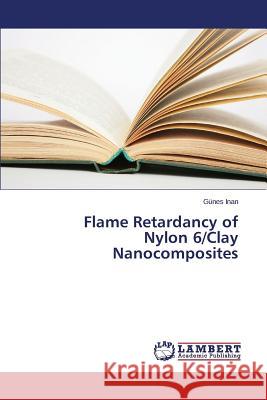Flame Retardancy of Nylon 6/Clay Nanocomposites » książka
Flame Retardancy of Nylon 6/Clay Nanocomposites
ISBN-13: 9783659760228 / Angielski / Miękka / 2015 / 132 str.
The thermal and flammability properties of nylon 6 nanocomposites, based on Na+-Laponite(r) (LP) and Na+-Montmorillonite (MMT) nanoparticles were investigated. Nylon 6/LP (5 wt%), nylon 6/MMT (5 wt%), and nylon 6/LP/MMT (2.5 / 2.5 wt%) nano-composites were prepared using a hydrolytic in-situ polymerization technique. Having 2- to 7-fold difference in particle aspect ratios and 0.5-fold difference in particle surface charges, LP and MMT nanoparticles produced 45 and 51 % reduction in peak heat release rate (peak HRR) of nylon 6, respectively. LP and MMT nanoparticles were both very effective in forming a porous char layer. Heat transfer through porous nanocomposite chars were examined using a combined one-dimensional diffusion equation for conduction and radiation heat transfer. The primary reasons for reduced burning rates of nylon 6/clay nanocomposites were (i) the formation of a low thermal conductivity char layer, which dramatically reduced the conduction and radiation heat transfer to the virgin polymer, and (ii) the high surface area and surface temperature of that char, which played a significant role in intensifying the radiation heat loss to the surrounding.
The thermal and flammability properties of nylon 6 nanocomposites, based on Na+-Laponite® (LP) and Na+-Montmorillonite (MMT) nanoparticles were investigated. Nylon 6/LP (5 wt%), nylon 6/MMT (5 wt%), and nylon 6/LP/MMT (2.5 / 2.5 wt%) nano-composites were prepared using a hydrolytic in-situ polymerization technique. Having 2- to 7-fold difference in particle aspect ratios and 0.5-fold difference in particle surface charges, LP and MMT nanoparticles produced 45 and 51 % reduction in peak heat release rate (peak HRR) of nylon 6, respectively. LP and MMT nanoparticles were both very effective in forming a porous char layer. Heat transfer through porous nanocomposite chars were examined using a combined one-dimensional diffusion equation for conduction and radiation heat transfer. The primary reasons for reduced burning rates of nylon 6/clay nanocomposites were (i) the formation of a low thermal conductivity char layer, which dramatically reduced the conduction and radiation heat transfer to the virgin polymer, and (ii) the high surface area and surface temperature of that char, which played a significant role in intensifying the radiation heat loss to the surrounding.











